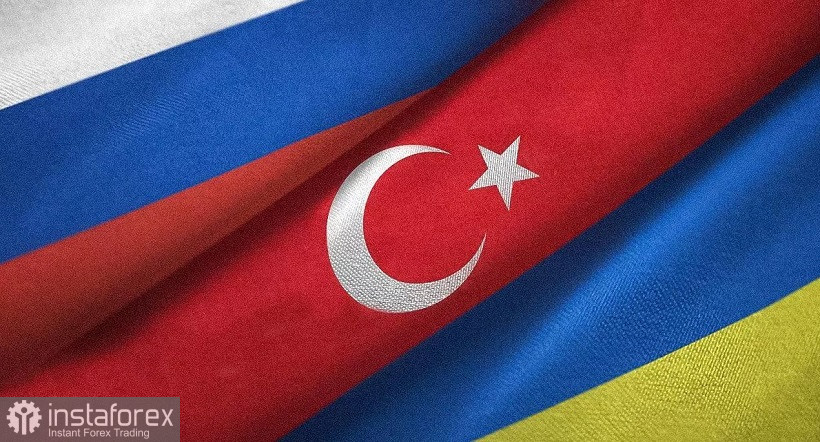The euro-dollar pair is trying to settle within the 11th figure, on the wave of a decline in anti-risk sentiment and a decrease in demand for the US currency. But despite the changed fundamental background, EUR/USD bulls fail to develop the upward offensive without hindrance. For example, following the results of yesterday, traders were forced to return to the area of the 10th figure, having met with resistance from bears. A similar picture is observed today. The EUR/USD bulls are having a hard time getting every point they gain. And despite the repeated assault on the 11th figure, the pair's further growth prospects are still vague. The contradictory price dynamics is explained by several fundamental factors at once.

Firstly, there are peculiar "aftershocks" of yesterday's negotiations in Turkey on the market. Let me remind you that representatives of Russia and Ukraine acknowledged for the first time yesterday that the last round of negotiations was held in a "constructive manner". Against the background of the general previous skepticism, such optimistic rhetoric allowed EUR/USD bulls to organize a large-scale offensive. The price updated the 2.5-week high and was marked in the area of the 11th figure.
But, as often happens in such cases, excessive optimism is then replaced, if not by disappointment, then by some wariness. In other words, as soon as the first positive emotions subsided, a completely natural and logical question arose: "what, exactly, next?". And this question remains unanswered so far. There are a lot of assumptions, expert opinions and comments from politicians on both sides. However, at the moment none of them can orient market participants regarding the future prospects of the situation. The participants of the negotiating groups agreed, or to be more precise, only outlined their positions, which, apparently, coincided on some points. On the one hand, against the background of previous rounds of negotiations, the Istanbul meeting can be considered a "breakthrough". On the other hand, it is obvious that the parties still need to overcome a certain and rather long way of agreeing on a future treaty, having crystallized a common position on many sub-items. Thus, according to the representative of the Ukrainian delegation, the date of the next round of negotiations will be known "after improvements in the subgroups and Russia's reaction to the concept of the general agreement." In addition, according to the head of the Russian delegation, Vladimir Medinsky, Moscow will put forward counter initiatives after considering Ukraine's proposals.
It is also necessary to quote the latest statements of Russian President Vladimir Putin's press secretary Dmitry Peskov, who also commented on the results of the Istanbul meeting today. He called the fact that Kiev has formulated concrete proposals to resolve the situation a positive moment. But in general, he does not consider the results of the meeting "breakthrough". In other words, the Kremlin did not see a breakthrough in the negotiations in Istanbul, but at the same time noted some progress in this process. Such a position can be interpreted in different ways in the context of trade decisions - on the one hand, today's rhetoric is more restrained, on the other hand, yesterday's meeting de facto shifted the negotiation process from a dead point. By the way, today Vladimir Medinsky said that Ukraine yesterday "for the first time recorded its readiness to fulfill a number of important conditions for building good-neighborly relations with Russia."
Thus, the fundamental background is no longer unipolar, but rather contradictory.
In addition to the Russian-Ukrainian negotiations, there is another topic of a fundamental nature that affects the EUR/USD pair. We are talking about the "gas issue". Many European countries have previously rejected Moscow's proposal to pay for Russian gas in rubles. In response, Russia hinted at cutting off the supply of "blue fuel" in the near future. However, Dmitry Peskov clarified today that the process of paying for Russian gas supplied to "unfriendly countries" in rubles will not be launched directly on March 31. According to him, this is a time–consuming process - the corresponding payment mechanism will eventually be made public. This fact has reduced the degree of heat in this matter. In addition, according to a number of experts, the European Union will in any case be forced to look for common ground with Russia, since it does not have the ability to promptly diversify energy supplies.
Thus, the overall situation so far is in favor of further EUR/USD growth, although this growth is likely to be accompanied by downward pullbacks. Risk appetite still prevails, despite the ongoing geopolitical instability. The market focuses its attention on optimistic theses, while simultaneously shading cautious and skeptical assessments.
From a technical point of view, the pair is currently testing the resistance level of 1.1150 – this is the average line of the Bollinger Bands indicator on the daily chart. This is an important target that will become a kind of marker for EUR/USD bulls. If at the end of today the bulls remain above this level, they will open their way to the next price barrier of 1.1240 (the average line of the Bollinger Bands coinciding with the Kijun-sen line on the weekly chart). You can consider long positions only after bulls gain a foothold above 1.1150 (at the moment, bears are trying to counterattack by opening short positions). Short positions for today are extremely risky in nature, due to the decline in anti-risk sentiment and the weakness of the US currency.
 English
English 
 Русский
Русский Bahasa Indonesia
Bahasa Indonesia Bahasa Malay
Bahasa Malay ไทย
ไทย Español
Español Deutsch
Deutsch Български
Български Français
Français Tiếng Việt
Tiếng Việt 中文
中文 বাংলা
বাংলা हिन्दी
हिन्दी Čeština
Čeština Українська
Українська Română
Română

